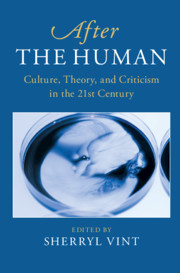Book contents
- After the Human
- After Series
- After the Human
- Copyright page
- Contents
- Contributors
- Acknowledgments
- Introduction
- Part I After Humanism
- Part II New Objects of Enquiry
- Chapter 6 Machines, AIs, Cyborgs, Systems
- Chapter 7 Animals
- Chapter 8 Life “Itself”
- Chapter 9 The Anthropocene
- Chapter 10 The Inorganic
- Part III Posthumanities
- Collective Works Cited
- Index
Chapter 8 - Life “Itself”
from Part II - New Objects of Enquiry
Published online by Cambridge University Press: 26 November 2020
- After the Human
- After Series
- After the Human
- Copyright page
- Contents
- Contributors
- Acknowledgments
- Introduction
- Part I After Humanism
- Part II New Objects of Enquiry
- Chapter 6 Machines, AIs, Cyborgs, Systems
- Chapter 7 Animals
- Chapter 8 Life “Itself”
- Chapter 9 The Anthropocene
- Chapter 10 The Inorganic
- Part III Posthumanities
- Collective Works Cited
- Index
Summary
Changing practices in contemporary biosciences and biotechnology have altered definitions and understandings of what we call “life”—what we mean by this term, what constitutes life, and how human and nonhuman others experience life. This chapter explores the shifting definitions of life within the biosciences, and beyond—which have emerged due to specific bioscientific/biotech advancements and changing political-economic imperatives and governing logics that have emerged during the latter half of the twentieth century. Increasingly, now, life as we know it has come to be manipulated, customized, optimized, maximized, and commodified. The chapter considers how life is increasingly technologized, how life is now understood as an ‘open dynamism,’ how life is something now viewed as subject to self-governance, and how life has become a domain of biovalue. While concepts of life and life-making strategies might have altered, historic inequities have not receded but are instead re-secured and often exacerbated.
Keywords
- Type
- Chapter
- Information
- After the HumanCulture, Theory and Criticism in the 21st Century, pp. 120 - 133Publisher: Cambridge University PressPrint publication year: 2020
- 1
- Cited by



